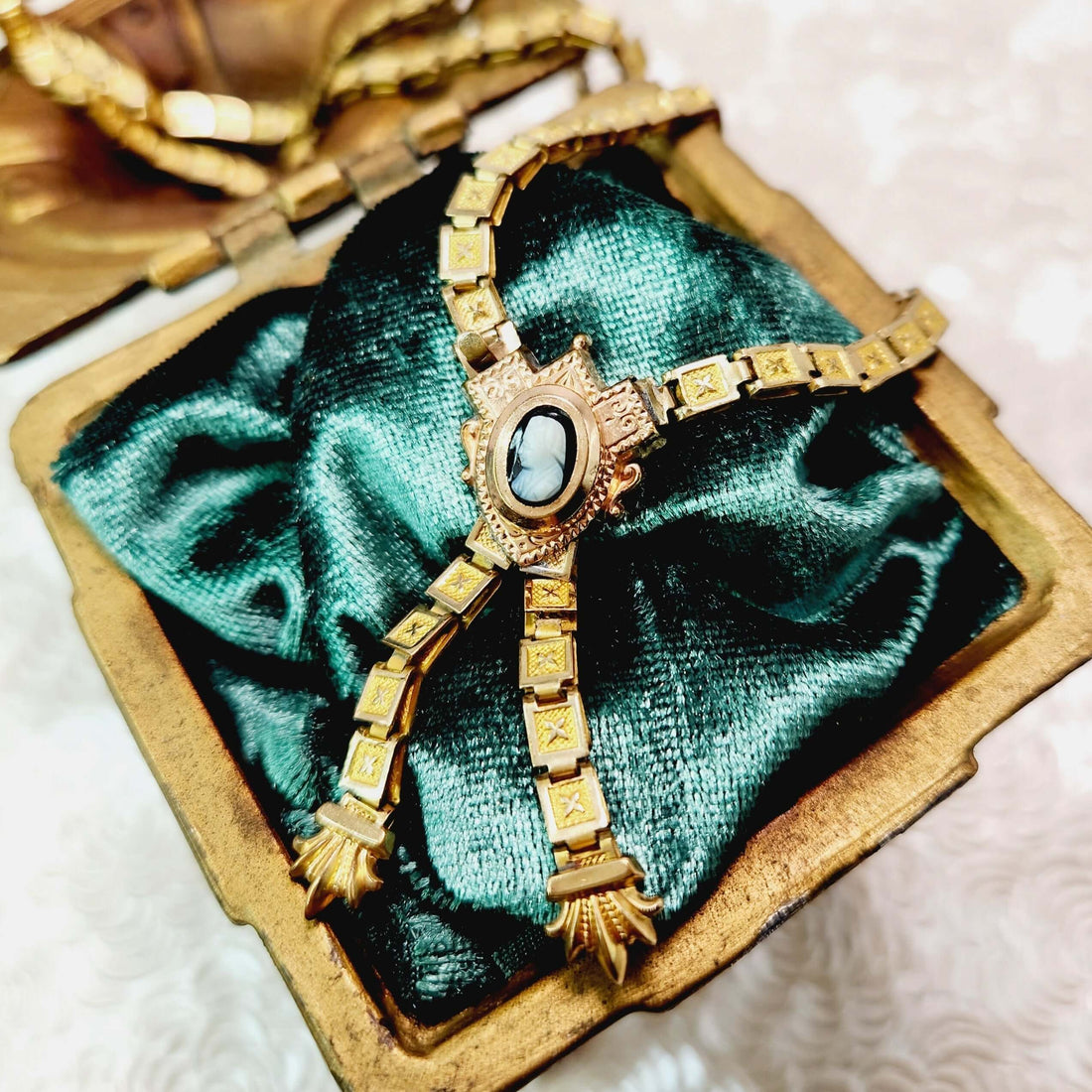Many experienced mourning during the Grand Period, primarily due to the Civil War. However, the period was also prosperous due to the rapid advancement of technology and culture. It ended in 1885. In the following article, we’ll discuss the jewelry of the sunset of Victoria’s reign, the Aesthetic Period.

Jewelry of the Victorian Grand Period
by Kat Paulick
The beginning of Queen Victoria’s reign was marked by romance and a sense of sentimentality. The young queen’s blossoming relationship with her husband, Prince Albert, softened British culture and the trends in jewelry and fashion. In 1861, however, tragedy struck for Victoria when Albert died prematurely. Etiquette dictated a period of two years of mourning, during which a widow would withdraw from society and wear all black to symbolize her loss. But Victoria had been deeply in love with her husband and wore mourning clothes and jewelry for the next forty years. Under her influence, black jewelry, also known as mourning jewelry, made from jet, onyx, black enamel, and bog oak, became a wardrobe staple during the mid-Victorian era, also known as the Grand Period (1861-1885).

Queen Victoria in her Mourning Garb. Image: Shutterstock
Many cultural and technological forces in the mid-19th century influenced the jewelry era. The 1860 discovery of silver in Nevada, United States, provided a consistent supply of precious metals, bringing down their prices. In 1867, a diamond mine was discovered in South Africa, marking a significant breakthrough in diamond mining. The industry was booming. Women worked as clerks, teachers, and housekeepers and won the right to keep their earnings. As prosperity grew, jewelers began to create more opulent styles. Where Romantic Period jewelry had been delicate and light, Grand Period jewelry was often massive and heavy. Large pendants hung from ladies’ necks, and bulky bangles encircled wrists.

1880s Locket with Book Chain. Image: The Gemmary
Romantic Period jewelry often featured intricate cannetille and repoussé metalwork, but in the Grand Period, the focus shifted from settings to gemstones. More jewelry featured pavé and gypsy settings. In pavé, the metal is nearly invisible, with stones “paving” the piece. Gypsy or flush settings mount the stone in an indentation so the gem lies flush with the metal. Jewelers flaunted their skills by embedding gems directly into cabochons. The star was a particularly popular motif, along with acorns, crosses, daisies, hearts, and realistic jeweled insects of all types. In Victorian Jewellery, Margaret Flower writes of this unusual trend:
“Bonnets and veils were covered with every kind of beetle…parasols were liberally sprinkled with ticks, with grasshoppers, with woodlice. Veils were sown with earwigs, with cock-chafers, with hornets…” (iii)

Garnet Carbuncle and Seed Pearl Ring in Rose Gold. Image: The Gemmary
The early Victorian interest in ancient cultures endured with continued archeological digs, and Greek, Roman, and Egyptian designs remained fashionable. Jeweler Augusto Castellani gained international fame for his expert craftsmanship in creating Greek and Etruscan jewelry, contributing to the enduring popularity of Renaissance jewels. On the other hand, seed pearls fell out of style, replaced by long strands of larger pearls.

Kul-Oba Brooch. Made by Fortunato Pio Castellani Sons, Italy
Another unique trend was jewelry crafted from human hair. Victoria was a fan of the style, and a life-size portrait of her made entirely from human hair was displayed at the 1855 World’s Fair in Paris. Hair continued to have a place in memorial jewelry, but was primarily incorporated invisibly into a piece rather than being featured prominently.

Technology, both in and outside of jewelry-making, continued to improve. The steam-powered diamond-bruting machine was invented in 1874, making cutting diamonds easier and more precise. The incandescent light bulb appeared in 1879. Historians believe that its invention led to a decrease in the popularity of brightly colored jewelry, which seemed gaudy under bright lights, and an increase in the popularity of diamonds.

